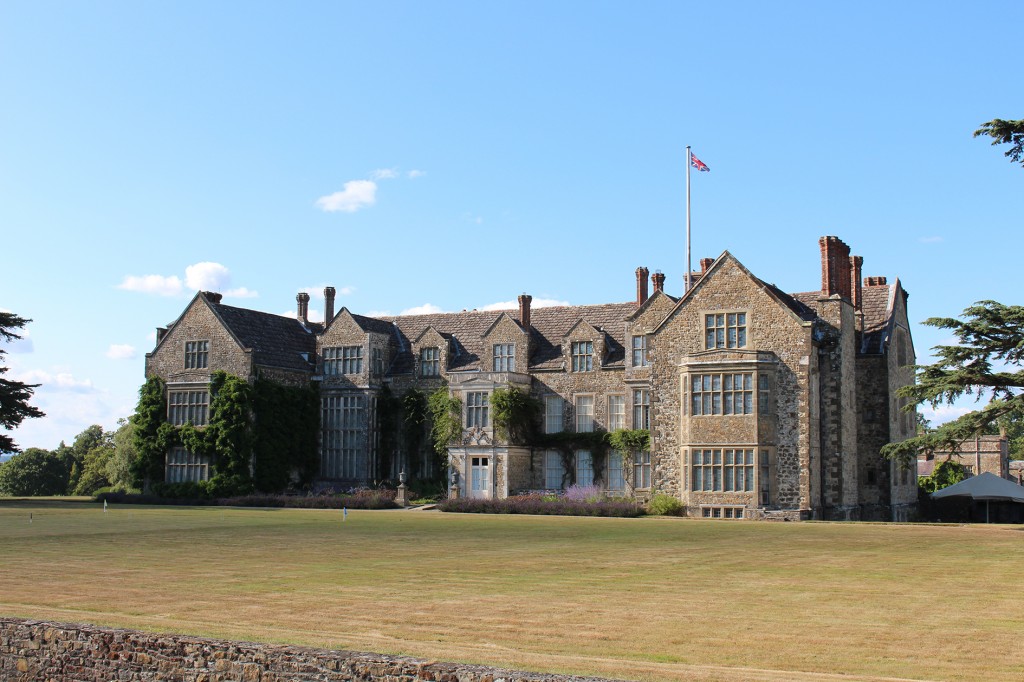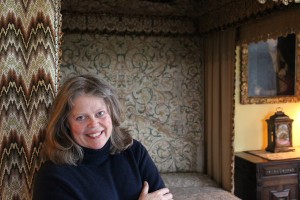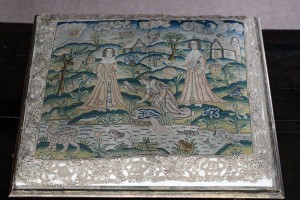
This week I am visiting Lady Emma Barnard at Parham House and Gardens. As we walk through this wonderful house, I am struck by the quality of the famous needlework in the collection. We come to the Great Chamber and are greeted by the gentle light of this spring afternoon. Lady Emma’s great-grandparents, Clive and Alicia Pearson, bought Parham in 1922 and set about restoring the house and gardens after years of neglect. The Great Chamber was remodelled in 1924 to become Alicia Pearson’s bedroom.

At the heart of the room is the Great Bed. Emma explains: “My great-grandfather, Clive Pearson, purchased the bed from Wroxton Abbey in Oxfordshire and brought it to Parham. It is partly Tudor and probably from the court of Henry VIII.”
The exquisite headboard, backcloth, canopy and bedspread are delicately embroidered with interwoven monograms and fleurs-de-lys within an overall design of flower and leaf tendrils. It is thought that they date from about 1585 and are of French or Italian workmanship. The two sets of curtains, pelmets and valances are also rare. They date from around 1620 and are worked with flame stitch embroidery.
Emma quickly draws my attention to an extraordinary mid-17th-century embroidered panel depicting ‘The Finding of Moses’. She remarks enthusiastically, “My husband, James, and I love this piece. It was a great favourite of Great-aunt Veronica’s too.” Veronica Tritton lived at Parham before Emma and her family.
The scene depicted on this needlework panel is from the Old Testament story in Exodus, chapter 2, in which Pharaoh orders all the newborn Israelite boys to be killed. Moses is hidden by his mother in a cradle amongst the bulrushes of the Nile. Pharaoh’s daughter discovers Moses and brings him up as her son. The story of Moses is one of obedience, leadership and salvation. Lady Emma points to the three women in the scene and exclaims, “Look how surprised they are to find him; they’ve two sets of eyebrows! It’s so finely worked, thirty stitches to the inch, and the details are amazing. Look at the sun with a face, the caterpillar, grasshopper, leopard and even a kingfisher with a fish in its beak. The more you look at it, the more fantastic it is. But those eyebrows, so surprised.” This family favourite is signed with the embroidered initials ‘ML’ and dated ‘1644’.

The embroidery of ‘The Finding of Moses’ at Parham has traditionally been considered to be a christening cushion. The textile specialist and conservator Dr Mary M. Brooks has suggested that this particular scene might reasonably be interpreted as reflecting concerns about political loyalties, issues surrounding royal succession and personal concerns, such as the safe upbringing of male heirs at this time.
These interpretations and the date of the panel, 1644, have a significance for Parham and its history. On 6th January 1644 Arundel Castle was surrendered to Sir William Waller, leader of the Parliamentarians, during the English Civil War. Amongst the prominent ‘hostages’ from the besieged castle, demanded by Waller as part of the treaty of surrender, was Sir Edward Bishopp, 2nd Baronet and owner of Parham. Sir Edward had fought at Winchester, Portsmouth and Arundel for the Royalist cause. He was taken to the Tower of London and heavily fined by the House of Commons.
Returning to the kitchen, we sit drinking tea in this timeless place, looking out over the park and gardens. I am reminded how important objects can be in bringing the common narrative of our island nation’s history to life.
Lady Emma and her family bring such life to Parham through their delight in this place, its history, collections and their desire to share it with others. We are blessed that Parham has such passionate, dedicated and generous custodians.
Parham House and its collections provide a window to our past and our future. Whether you are visiting for the first time or returning, Parham never fails to captivate and delight anew.
Parham House and Gardens are open until the end of September on Wednesdays, Thursdays, Fridays, Sundays and this May Bank Holiday Monday, at 2pm and 12pm respectively, closing at 5pm. For more information go to www.parhaminsussex.co.uk or telephone 01903 742021.
Revd. Rupert Toovey. Originally published on 20th May 2015 in the West Sussex Gazette.